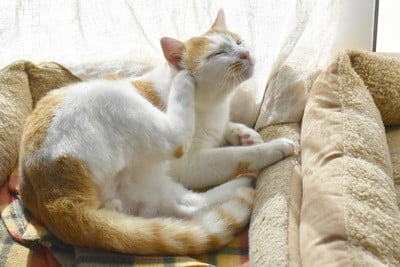We know that humans can be allergic to cats, but we often forget that cats have allergies, too. If your cat is wheezing, sneezing, or scratching incessantly, this could be due to an allergic reaction.
Allergens fall into 3 categories: food, household, and environmental. Food allergies cause bloating, vomiting, and diarrhea. Household and environmental allergies cause itchiness, wheezing, and lethargy. The most common allergens are beef, fragrances, and flea bites.
Allergies cannot be treated in the traditional sense, but they can be managed and controlled. One of the main challenges is figuring out what your cat is allergic to. We’ll identify the most common allergens in cats and show you how to keep them under control.
Do Cats Have Allergies?
Just under 5% of domestic cats in the U.S. get allergies, which equates to around 4.5 million cats across America. Allergies may be due to genetic factors, nutritional status, or being over-exposed or under-exposed to certain substances at a young age. Almost anything can cause an allergic response.
What Are the Symptoms of Allergies in Cats?
An allergic reaction occurs when the cat’s immune system feels threatened by a particular substance (an allergen). The cat’s immune system produces antibodies to fight off the threat, and it’s this overreaction that causes these symptoms:
- Itchiness and scratching
- Sneezing, coughing, and wheezing
- Runny eyes and nose
- Facial swelling
- Lethargy and loss of appetite
- Bloating, gas, vomiting, and diarrhea
- Anaphylaxis
You can predict what type of allergy your cat has by scrutinizing its symptoms. Itching, sneezing, and wheezing tend to occur in response to household/environmental allergies. However, bloating and diarrhea often indicate a food allergy. However, there can be some crossover between the two, and some cats may have multiple allergies.
Foods Allergy vs. Food Intolerance
Food allergies should be distinguished from food intolerances. Food allergies trigger an immune response, whereas food intolerances don’t. Also, a true food allergy can cause anaphylaxis, whereas a food intolerance can’t.
Many cats are intolerant to sucrose (simple sugar) and lactose (milk) because they don’t have enough of the enzymes needed to process these foods (sucrase and lactase). The main symptoms of food intolerance include bloating, gas, diarrhea, and itchy skin.
Most cats also digest complex carbohydrates (starches) at a slower rate than other animals, but this is not classed as an allergy. A true allergy is characterized by an immune response to a food substance. True food allergies are less common than intolerances, but they still affect up to 5% of cats.

Beef
Meat proteins are more likely to cause allergies than cereals or grains. According to tandfonline, beef is the most commonly diagnosed allergy in cats. It is 4 times more common than a poultry allergy and 5 times more common than a barley/wheat allergy. Low-priced cat foods contain beef byproducts because they are cheap and easy to source.
Dairy
Although many cats are lactose intolerant, a small number of cats are allergic to the casein (protein) in milk. You can usually tell if your cat is lactose intolerant or allergic to milk by the severity of its symptoms.
Cats that are lactose intolerant will experience bloating, mild itchiness, and diarrhea. Cats that are allergic to casein will often experience swelling, severe diarrhea, intense scratching, vomiting, and difficulty breathing.
Fish
Fish allergies are twice as common as wheat/barley allergies in cats. It is thought that salmon and tuna are most likely to cause an allergic reaction. Most owners should limit or avoid tuna because of its high level of mercury.
Household Allergens
What are cats allergic to inside the home? You’ll find that many household products are harmful to cats. Small amounts of ammonia (found in oven cleaners), bleach, and chlorine (found in many detergents) can be toxic.
That’s not because they are allergens, but because they are irritants. These products have the potential to cause skin damage, liver disease, and cancer. Though potentially toxic, ammonia, chlorine, and bleach are not usually considered allergens. Unlike allergens, these chemicals will cause harm to all cats, not just a few.
Fragrances
Fragrances in perfumes, air fresheners, liquid cleaners, fabric conditioners, candles, cat litters, and oil burners/diffusers. 26 fragrance compounds cause allergic reactions in a small percentage of animals. The most common culprits include:
- Benzyl alcohol
- Benzyl salicylate
- Cinnamyl alcohol
- Cinnamal
- Citral
- Coumarin
- Eugenol
- Hydroxycitronella
Fragrances can be inhaled or come in direct contact with the cat’s skin. For example, if you wash your floor with a fragranced floor cleaner and your cat lays on the floor, it will come into contact with the substance.
Inhaling the fragrance may cause a runny nose, wheezing, and lethargy. If the fragrance comes into contact with the cat’s skin, this may cause scratching/itching, redness, bumpy skin, and swelling.
Going natural with your products is not enough because natural, organic, chemical-free products still may contain essential oils or fragrance compounds that are allergenic. Look for scent-free cleaning products and cat litters and avoid scented candles completely.
Wool (Lanolin)
Some cats are allergic to the lanolin in wool products. Lanolin is the greasy substance that animals secrete onto their wool to keep it clean and waterproof. Cats that have a lanolin allergy will probably experience:
- A rash or bumps on the skin
- Scratching
- Lethargy
- Sore eyes / weepy nose
- Breathing problems (in severe cases)
Lanolin can be found in woolen blankets, rugs, and jumpers, but it is also extracted and used in some household and beauty products. According to the Department for Health and Human Services, lanolin can be found in:
- Leather cleaner
- Hand cleaners
- Haircare products, including pet haircare
- Cosmetics
- Paw Balm for pets
If you suspect a lanolin allergy, you may need to switch some of your cleaning products or cosmetics. Even if your cat doesn’t come in direct contact with these products, they may be inhaled or transferred by your own hands.
House Dust (Dust Mites)
Dust mites are tiny insects that live in house dust and are invisible to the naked eye. Keeping your house clean can help to protect against this allergy. This involves dusting and vacuuming daily. Also, you should get dust-free cat litter and wash your cat’s bedding regularly.
Environmental Allergens
Cats can be allergic to many different environmental factors; some are seasonal, while others affect cats year-round. If you have an outdoor cat, it may be hard to keep it away from several of these allergens:

Grass Pollen
3-5% of cats are thought to be allergic to at least one type of grass pollen. This allergy can cause symptoms such as wheezing, a dripping nose, and excessive scratching.
In the northern areas of the U.S., grass mostly pollinates in spring and early summer, but in the southern regions, grass tends to pollinate throughout the year.
If your cat enjoys the outdoors but has a grass allergy, it would be a shame to keep them inside permanently. There are other things you can do to minimize the effects:
- Pollen count check. Check local pollen counts daily and keep your cat inside if the count is very high. If the count is moderate, limit their time outdoors to 30 minutes.
- Short lawn. Keep the lawn very short at all times, and close all windows and doors when mowing the lawn.
- Washing fabrics. Wash your cat’s bed and blanket regularly.
- Cleanliness. If you’ve spent all day outdoors, wash your hands and change clothes before petting your cat.
- Specialist shampoo. A cat with a pollen allergy may benefit from being washed once a week with a specialist cat shampoo to remove pollen from their fur.
Grass, trees, mildew, and weeds can all cause allergic reactions in cats.
Flea Bites
Flea bites are the most common allergy of all. Cats that go outside and come into contact with other animals are more likely to encounter fleas, but indoor cats can also be affected. Symptoms of flea allergies include:
- Intense scratching
- Hair loss, bleeding, and black scabs
- Restlessness
- Coughing and wheezing
Treating fleas as soon as they arise is crucial. However, some cats are also allergic to flea treatment products. If you suspect your cat has a flea allergy, it’s best to take it to the vet for treatment. Your vet can choose a hypoallergenic treatment that’s less likely to cause further skin irritation.
It’s more common for allergies to develop in kittens and younger cats (less than one year old). However, an older cat can still develop an allergy. Older-onset food allergies are more common than other types of allergy.

